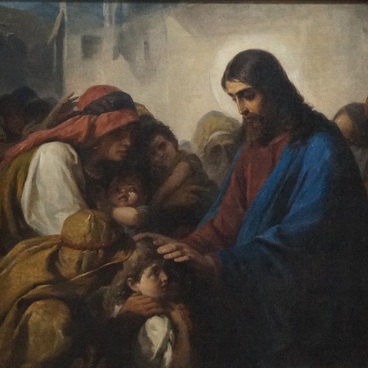The Blind Musician painting was created by an unknown graduate of the A.V. Stupin Arzamas School. As a rule, the impossibility to identify authorship in case of the Arzamas School paintings is determined by the fact that the artists were unfree serfs. Over the years, from the total number of 168 students of the school, 88 were serfs. According to art historian Pyotr Kornilov, in the early 19th century the Stupin Art School was ‘the only nursery of art knowledge for talented serfs’, whose numerous works still remain unattributed, because serfs did not have many civil rights, including author’s rights, and could not sign their pictures.
The painting school was established by Alexander Stupin in Arzamas of the Nizhny Novgorod Region in 1802 and became the first private art school in provincial Russia. It was a unique example of the academic art education model being implemented in a small town. Stupin’s initiative promoted further expansion of professional art training in provincial regions.
The Blind Musician is based on a familiar subject in world art. It depicts a blind old musician with a guide boy on the shore of the sea. The musician’s face framed by silver curls and his left hand are pointed up towards the sky. The old man is wearing black flowing garments and on his back there is a lyre, an ancient string instrument. He is wearing clothes and shoes typical of Ancient Rome. He is in sandals, the most common type of ancient footwear: a sole made of rawhide was attached to the ankle with strings.
With his right hand the old man is leaning on the shoulder of the guide boy. The boy is wearing a yellow tunic; in his left hand he is holding a rod, while his right hand is touching the old man’s arm. The boy’s face is light, with big eyes and dark curly hair. In the background are raging sea waves and the sky with dark clouds. Far left against the waves is depicted a floating sailboat.
One more graduate of the A.V. Stupin Arzamas School turned to the same subject of a blind musician: it was Vasily Perov. He created his Blind Musician sometime around 1864. This painting became a sketch for The Seller of Song-Books in Paris, which is now kept in the Tretyakov Gallery.
The painting school was established by Alexander Stupin in Arzamas of the Nizhny Novgorod Region in 1802 and became the first private art school in provincial Russia. It was a unique example of the academic art education model being implemented in a small town. Stupin’s initiative promoted further expansion of professional art training in provincial regions.
The Blind Musician is based on a familiar subject in world art. It depicts a blind old musician with a guide boy on the shore of the sea. The musician’s face framed by silver curls and his left hand are pointed up towards the sky. The old man is wearing black flowing garments and on his back there is a lyre, an ancient string instrument. He is wearing clothes and shoes typical of Ancient Rome. He is in sandals, the most common type of ancient footwear: a sole made of rawhide was attached to the ankle with strings.
With his right hand the old man is leaning on the shoulder of the guide boy. The boy is wearing a yellow tunic; in his left hand he is holding a rod, while his right hand is touching the old man’s arm. The boy’s face is light, with big eyes and dark curly hair. In the background are raging sea waves and the sky with dark clouds. Far left against the waves is depicted a floating sailboat.
One more graduate of the A.V. Stupin Arzamas School turned to the same subject of a blind musician: it was Vasily Perov. He created his Blind Musician sometime around 1864. This painting became a sketch for The Seller of Song-Books in Paris, which is now kept in the Tretyakov Gallery.



